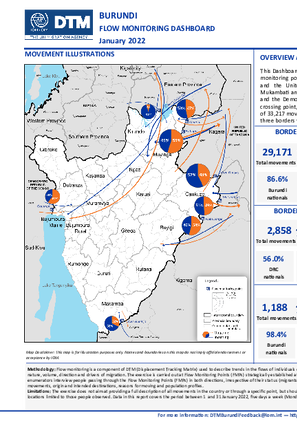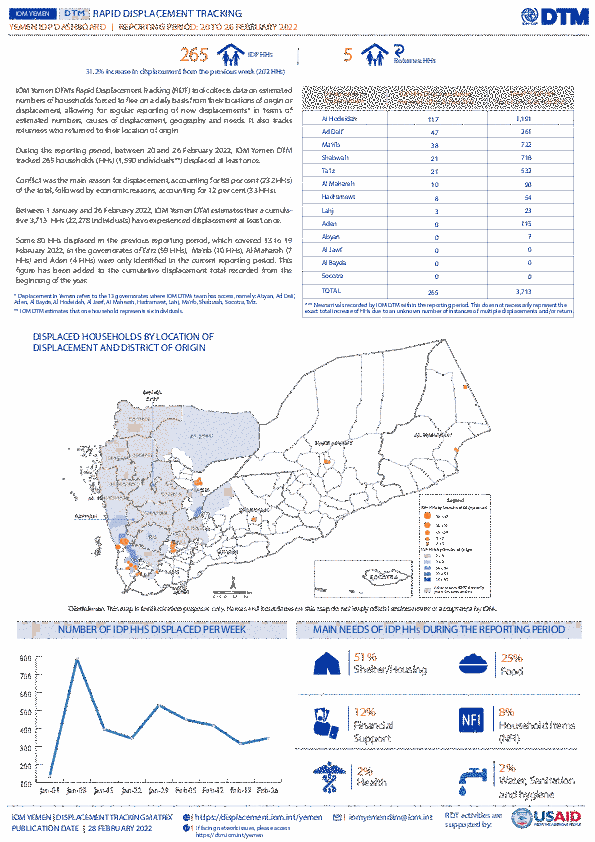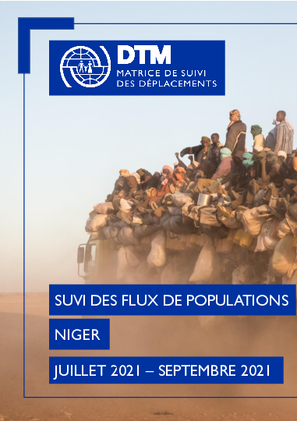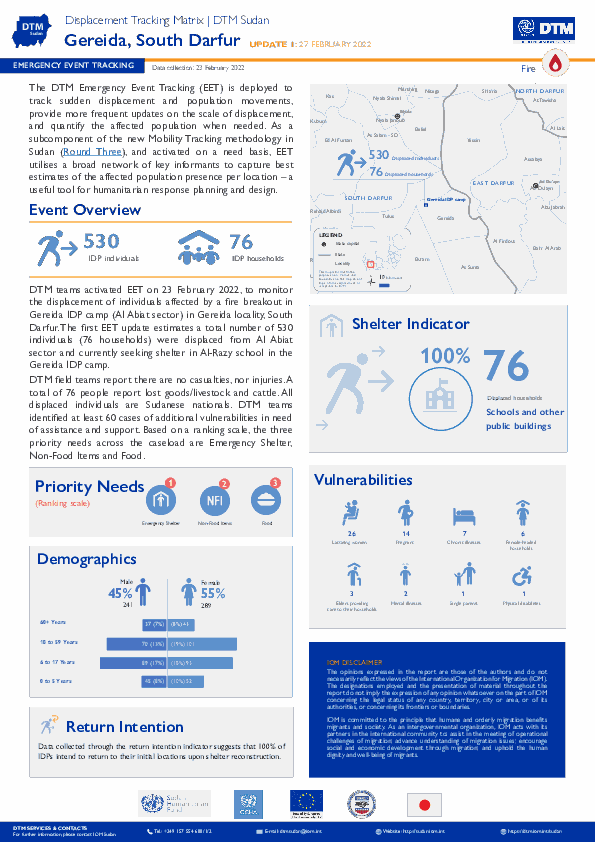-
Countries
-
Data and Analysis
-
Special Focus
-
Crisis Responses

Contact
DTMBurundi@iom.int
Language
English
Location
Burundi
Period Covered
Jan 01 2022
Jan 31 2022
Activity
- Flow Monitoring Survey
- Flow Monitoring
This Dashboard provides an analysis of the trends in population mobility observed at eight (8) flow monitoring points (FMPs), six (6) established at unofficial border crossing points between Burundi and the United Republic of Tanzania border at Kabogo, Kwa Rutuku, Mbundi, Kabuyenge, Mukambati and Kwa Buhinja; one (1) established at official border crossing point, between Burundi and the Democratic Republic of the Congo at Gatumba and one (1) established at official border crossing point, between Burundi and Rwanda at Gasenyi-Nemba. Over the reporting period, a total of 33,217 movements were observed at these points. About 51.6 per cent of all movements at the three borders were incoming and 48.4 per cent were outgoing.
The Displacement Tracking Matrix (DTM) in the East and Horn of Africa is currently active in six countries (Burundi, Djibouti, Ethiopia, Somalia, South Sudan and Uganda), and its methodology includes four main components (mobility tracking, flow monitoring, registrations and surveys).
As of December 2021, 9.8M internally displaced persons (IDPs) and 3.3M returnees were tracked in the region, as reported during the last round of DTM assessments for each country or through secondary data sources

Contact
DTM Libya, DTMLibya@iom.int
Language
English
Location
Libya
Period Covered
Feb 20 2022
Feb 26 2022
Activity
- Other
As part of the the second phase of the Libyan national COVID-19 vaccination campaign led by the Libyan National Centre for Disease Control (NCDC), IOM conducted awareness raising sessions on COVID-19 vaccines with a total of 566 adult migrants (52 females and 514 males) in four locations, Ain Zara detention centre and community settings in three municipalities during the reporting period (20 - 26 Feb 2022).

Contact
DTM Somalia, IOMSomaliaDTM@iom.int
Language
English
Location
Somalia
Period Covered
Jan 01 2022
Jan 31 2022
Activity
- Flow Monitoring
In January 2022, a total of 31,960 movements were observed at 7 Flow Monitoring Points (FMPs). This represents an increase of 34 per cent in comparison with December 2021 when 23,779 movements were observed.

Contact
DTMcovid19@iom.int
Language
English
Location
Global
Snapshot Date
Feb 21 2022
Activity
- Other
The current outbreak of COVID-19 has affected global mobility in the form of various travel disruptions and restrictions. To better understand how COVID-19 affects global mobility, DTM has developed a COVID-19 database mapping the different restrictions to provide a global overview. For this, DTM uses the IATA site as the primary source of restrictions with the information reported per country and territory, and to the country of application.
Data collected includes:
- Date of restriction
- Country, territory or area of restriction
- Countries, territories or areas on which restrictions were imposed
- Type of restriction- total restriction, or conditional restriction – such as medical/ and or visa restriction
This DTM COVID-19 Travel Restrictions Output presents an analysis based on country imposing, the country being imposed upon, and the aggregation of the restriction type. The aim of the data analysis is to provide an overview of the COVID-19 outbreak on global mobility and to help identify and develop responses.

Contact
DTM Yemen, iomyemendtm@iom.int
Language
English
Location
Yemen
Period Covered
Feb 20 2022
Feb 26 2022
Activity
- Rapid Emergency Registration
- Mobility Tracking
IOM Yemen DTM’s Rapid Displacement Tracking (RDT) tool collects data on estimated numbers of households forced to flee on a daily basis from their locations of origin or displacement, allowing for regular reporting of new displacements in terms of estimated numbers, geography, and needs. It also tracks Returnees who returned to their location of origin.
From 01 January 2022 to 26 February 2022, IOM Yemen DTM estimates that 3,713 households (HH) (22,278 Individuals) have experienced displacement at least once.
Since the beginning of 2022, DTM also identified 11 displaced households who left their locations of displacement and either moved back to their place of origin or another location.
Between 20 and 26 February 2022, IOM Yemen DTM tracked 265 households (1,590 individuals) displaced at least once. The majority of people moved into/within the following governorates and districts:
- Al Hodeidah (117 HH) – Hays (105 HH), Al Khukhah (12 HH) districts. Most displacements in the governorate were internal.
- Ad Dali (47 HH) – Qatabah (23 HH), Ad Dali (22 HH), Jahaf (2 HH) districts. Most displacements in the governorate originated from Ad Dali and Al Hodeidah.
- Marib (38 HH) – Marib City (28 HH), Marib (10 HH) districts. Most displacements in the governorate originated from Marib and Ibb.
The majority of people moved from the following governorates and districts
- Al Hodeidah (137 HH) – Hays (99 HH), Al Jarrahi (11 HH), Bayt Al Faqih (7 HH) districts.
- Taiz (28 HH) – Maqbanah (19 HH), Mawza (5 HH), Hayfan (2 HH) districts.
- Marib (22 HH) – Al Abdiyah (13 HH), Marib City (12 HH), Al Jubah (4 HH) districts.

Contact
DTM Niger, DTMNiger@iom.int
Language
French
Location
Niger
Period Covered
Jul 01 2021
Sep 30 2021
Activity
- Survey
- Flow Monitoring Survey
- Flow Monitoring
Ce document propose une analyse de 6 707 enquêtes individuelles menées entre Juillet et Septembre 2021 auprès de voyageurs transitant par les sept points de suivi de flux populations (FMP) : d'Arlit, de Séguédine et Madama, de Magaria, de Dan Barto, de Dan Issa et de Tahoua. Ces enquêtes font partie des activités de suivi des flux mises en œuvre par l'OIM via la matrice de suivi des déplacements (DTM). L'objectif de ces activités est de collecter des informations sur le nombre et les profils des populations mobiles aux points de transit stratégiques situés dans les zones à forte mobilités. Les enquêtes sont menées quotidiennement avec un échantillon de personnes choisies au hasard et observé aux points de transit.
The current outbreak of COVID-19 has affected global mobility in the form of various travel disruptions and restrictions. To better understand how COVID-19 affects global mobility, IOM has developed a global mobility database to map and gather data on the locations, status and different restrictions at Points of Entry (PoEs), globally. In the East and Horn of Africa (EHoA) region, IOM’s Displacement Tracking Matrix (DTM) teams in nine of the ten countries covered by IOM Nairobi Regional Office are actively collecting information on various PoEs, internal transit locations, as well as other areas of interest in an effort to better understand the extent of these restrictions, as well as the impact on different types of population groups. This report is developed as a close collaboration between IOM’s divisions and units, in particular: DTM, Migration Health Division (MHD), Immigration and Border Management (IBM), and Migrant Protection and Assistance Division (MPA).
Data is collected about the following locations:
• Airports (currently or recently functioning airport with a designated International Air Transport Association -IATA- code)
• Blue Border Crossing Points (international border crossing point on sea, river or lake)
• Land Border Crossing Points (international border crossing point on land)
• Internal Transit Points (internal transit point inside a given country, territory or area)
• Areas of interest (region, town, city or sub-administrative unit in a given country, territory or area with specific restrictions)

Contact
DTM Yemen, DTMYemen@iom.int
Language
English
Location
Yemen
Period Covered
Jan 01 2021
Dec 31 2021
Activity
- Flow Monitoring
- Mobility Tracking
- Baseline Assessment
Yemen, despite the ongoing humanitarian crises in the country, continues to be a major transit point along the eastern migration route between the Horn of Africa (HoA) and the Kingdom of Saudi Arabic (KSA). IOM’s DTM recorded 27,693 migrant arrivals in Yemen in 2021, through ten flow monitoring points (FMPs) operating at key migrant transit locations along the southern coast in the governorates of Lahj, Shabwah, Hadramawt and Ta’iz. Irregular migrants, mainly from Ethiopia, travel to Yemen via boats, from Djibouti and Somalia, and face severe protection risks, which worsen upon arrival in Yemen.
The main migration route starts from Ethiopia to the seaport city of Obock in Djibouti. Migrants then depart Obock and arrive at Bab Al Mandeb water strait, an area that spans the coasts of Lahj and Ta’iz governorates. A secondary route via Somalia gained traction following increased military patrolling along the main route between Djibouti and Yemen. Migrants departing from Bosaso in Somalia arrive at the coasts of Shabwah and Hadramawt in Yemen, where the journey is longer and precarious.
The majority of migrants intend to reach Saudi Arabia but for most, as DTM field staff have observed, their journey ends in Yemen. Migrants attempt to reach KSA through the Monabih district in Sada governorate, mainly through Al Raq, Al Gar and Al Thabet towns which fall on the northern border.
In pursuit of better economic opportunities, migrants endure heightened inhumane conditions. Migrants are amongst the most underserved, marginalized and at-risk population groups in Yemen. With the deepening of the political and security crisis in Yemen, migration dynamics in the country have remained perilous. Fleeing destitution, poverty and often violence, migrants in Yemen experience aggression, abuse and exploitation. The majority are living in dire conditions with extremely limited-to-no access to essential services such as shelter, food, water and healthcare.

Contact
DTM Sudan; dtmsudan@iom.int
Language
English
Location
Sudan
Snapshot Date
Feb 23 2022
Activity
- Event Tracking
- Mobility Tracking
The DTM Emergency Event Tracking (EET) is deployed to track sudden displacement and population movements, provide more frequent updates on the scale of displacement, and quantify the affected population when needed. As a subcomponent of the new Mobility Tracking methodology in Sudan (Round Three), and activated on a need basis, EET utilises a broad network of key informants to capture best estimates of the affected population presence per location – a useful tool for humanitarian response planning and design.

